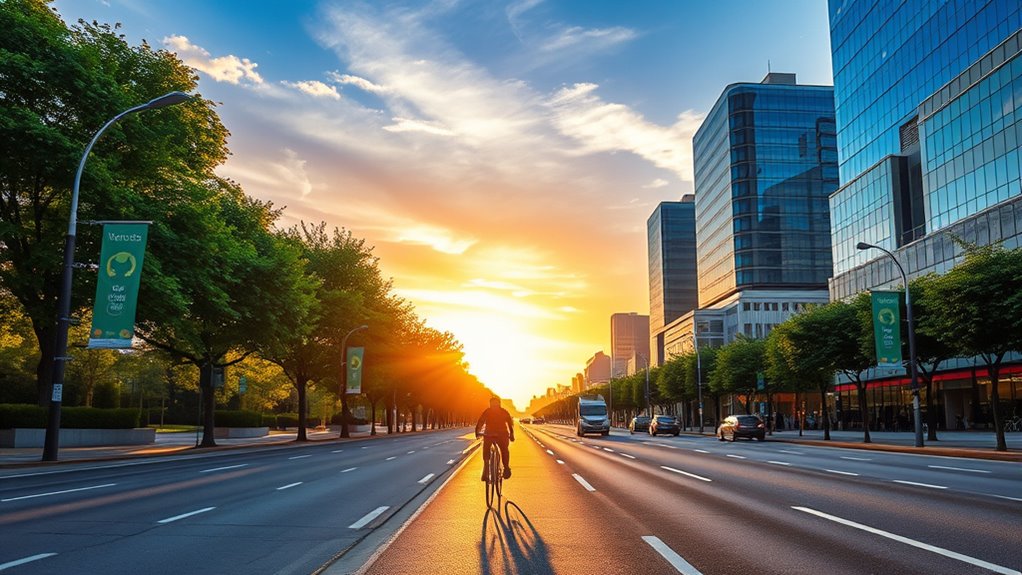Choosing to live without a car for a year and rely solely on a bike can drastically lower your carbon footprint and improve air quality. By pedaling instead of driving, you reduce greenhouse gases, decrease vehicle emissions, and promote healthier urban environments. You’ll conserve energy, reduce resource use, and support sustainable city development. If you want to understand how this lifestyle makes a lasting environmental difference, keep exploring the benefits that go beyond just personal health.
Key Takeaways
- Cycling for a year significantly reduces personal carbon footprint by eliminating emissions from car use and manufacturing.
- It improves urban air quality by decreasing vehicle tailpipe emissions and traffic congestion.
- Using only a bike promotes healthier lifestyles, reducing the environmental impact of vehicle maintenance and fuel consumption.
- A year without a car encourages sustainable urban development and community engagement through active transportation.
- Overall, it contributes to climate change mitigation by lowering greenhouse gases and conserving resources.
Reducing Carbon Emissions Through Pedal Power

Switching to a bike considerably cuts your carbon footprint because it produces no emissions during rides. When cities prioritize urban planning that integrates bike infrastructure, it becomes easier and safer for you to choose cycling over driving. Well-designed bike lanes and dedicated paths encourage more people to bike instead of using cars, reducing overall transportation emissions. By investing in bike infrastructure, communities promote sustainable mobility, which directly lowers greenhouse gases linked to transportation. Your decision to pedal instead of drive supports these efforts, making a tangible difference in urban air quality and climate change mitigation. The more cities develop extensive bike networks, the more accessible and appealing cycling becomes, enhancing transportation efficiency, and helping you contribute to a cleaner, greener environment. Creating a supportive environment for cyclists also encourages community engagement and healthier lifestyles. Additionally, promoting cycling aligns with mindful decluttering principles by fostering a simpler, less material-dependent lifestyle that benefits the environment. Moreover, fostering a creative practice around cycling can inspire innovative approaches to urban mobility and sustainable living. A focus on urban planning that prioritizes bike-friendly spaces can further accelerate this positive impact.
Decreasing Air Pollution Levels With Bicycle Transportation
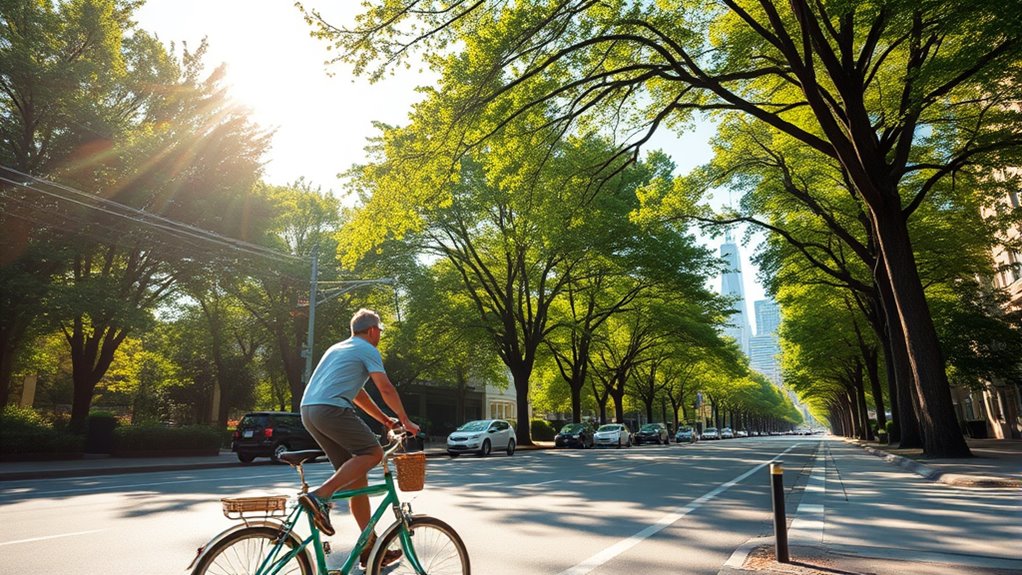
Bicycle transportation plays a crucial role in decreasing air pollution levels in urban areas. When you choose to bike instead of drive, you cut down emissions from vehicles that contribute to smog and poor air quality. To maximize these benefits, investing in quality cycling infrastructure makes your commute safer and more efficient. Regular bike maintenance ensures your ride stays smooth and reduces unnecessary emissions caused by mechanical issues. Here are four ways biking helps lower air pollution:
- Eliminates tailpipe emissions from personal vehicles
- Reduces congestion, allowing for better airflow
- Promotes cleaner air quality in densely populated areas
- Encourages community-wide adoption of eco-friendly transit
Additionally, promoting sustainable transportation initiatives can further enhance urban air quality and reduce overall environmental impacts. Supporting green mobility options encourages a shift away from fossil fuel dependence and fosters healthier communities. Incorporating active commuting as part of daily routines can also lead to improved public health and reduced healthcare costs. Moreover, adopting electric bikes can further decrease emissions associated with personal transportation.
Lowering Greenhouse Gas Footprints by Going Car-Free

When you go car-free, you naturally cut down on emissions that contribute to climate change. This choice helps lower your carbon footprint and supports sustainable transportation options. By making this switch, you actively reduce your impact on the environment. Additionally, cycling promotes health benefits, encouraging a more active lifestyle. Properly maintaining your bike and knowing fire safety practices can ensure safer rides and prevent accidents. Regularly checking your tires for wear and ensuring proper gear shifting can also enhance riding efficiency and safety. Engaging with celebrity lifestyle insights can also inspire sustainable habits and community involvement.
Reduced Emissions Naturally
Reducing your reliance on a car naturally leads to lower greenhouse gas emissions, making a tangible difference in combating climate change. Without a car, you cut emissions from fuel combustion and vehicle manufacturing. To maximize your impact, consider:
- Supporting carbon offsetting projects that absorb emissions elsewhere.
- Choosing renewable energy sources for your home to reduce indirect emissions.
- Opting for biking or walking instead of driving, directly lowering your carbon footprint.
- Advocating for policies that promote renewable energy and sustainable transportation.
In addition, adopting sound design principles in raising awareness campaigns can effectively communicate the importance of sustainable choices. These actions not only decrease your personal emissions but also encourage broader shifts toward cleaner energy. By eliminating your car, you contribute to a healthier planet, demonstrating how individual choices can support climate change mitigation. Incorporating behavior change strategies can further enhance the effectiveness of these initiatives, motivating more individuals to adopt eco-friendly habits. Additionally, understanding the carbon footprint of different transportation options helps in making more informed sustainable choices. Moreover, leveraging AI security technologies can assist organizations in protecting environmental data related to climate initiatives, ensuring the integrity and confidentiality of sustainability efforts.
Lower Carbon Footprint
Choosing to forego car ownership considerably shrinks your greenhouse gas footprint, making your daily activities more sustainable. Cycling produces zero emissions during travel, directly reducing your carbon footprint. By relying solely on your bike, you avoid the greenhouse gases released from vehicle manufacturing, fuel combustion, and maintenance. Ensuring bike safety is essential; wearing a helmet and following traffic laws protect you and promote cycling as a viable option. Well-designed cycling infrastructure, like dedicated lanes and bike-friendly paths, encourages safer riding and reduces the risk of accidents. As a result, you not only cut emissions but also foster a community that supports cleaner transportation. Over time, your commitment to cycling helps lower overall greenhouse gases, contributing to a healthier planet. Incorporating proper maintenance and quality gear can further enhance safety and efficiency during your rides. Additionally, supporting eco-friendly transportation policies can help expand infrastructure and promote sustainable commuting options. Adopting cycling as a primary mode of transportation also promotes physical health, adding a personal well-being benefit to your eco-friendly choice. Moreover, investing in electric bikes with high horsepower can make longer or more challenging rides more accessible, further encouraging the shift away from car use.
Sustainable Transportation Choices
Opting for sustainable transportation options considerably lowers your greenhouse gas emissions and promotes a healthier environment. Your choices influence urban planning and transportation infrastructure, encouraging cities to prioritize eco-friendly options. Here are four ways to make impactful decisions:
- Use bikes or walk whenever possible, reducing reliance on fossil-fuel vehicles.
- Support public transit systems that are efficient and low-emission.
- Advocate for urban planning that promotes bike lanes and pedestrian zones.
- Choose car-sharing or electric vehicles when necessary, aligning with sustainable infrastructure goals.
Impact on Urban Air Quality and Public Health
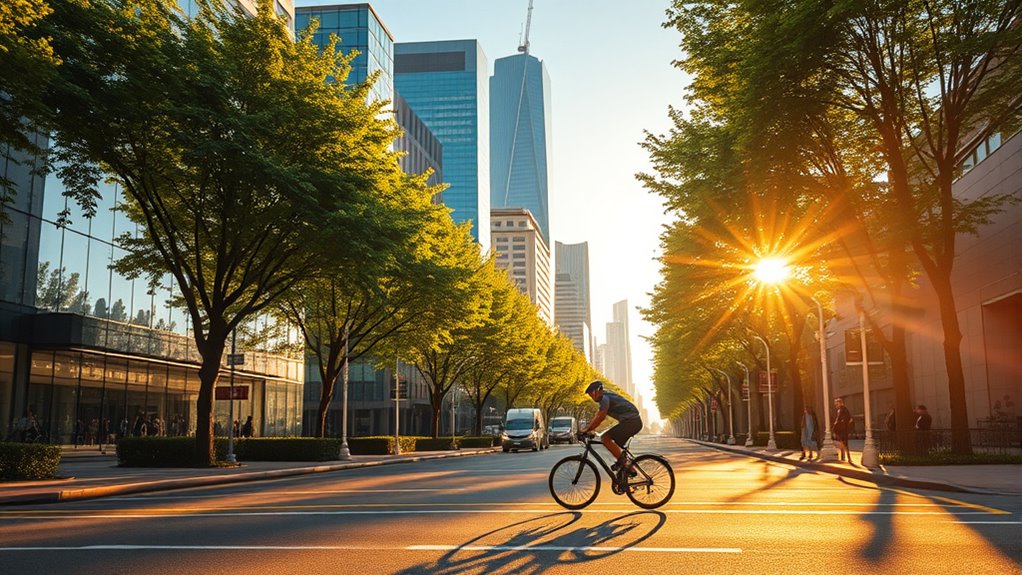
Spending a year solely on a bike substantially improves urban air quality by reducing emissions from vehicles. With fewer cars on the road, you’ll notice cleaner air, which benefits everyone’s respiratory health. Reduced vehicle traffic also lowers urban noise levels, creating a quieter, more peaceful environment. As you cycle through the city, pedestrian safety improves because there’s less risk of accidents caused by busy traffic. Less air pollution means fewer health issues like asthma and bronchitis, leading to overall better public health. Additionally, the decrease in noise pollution helps reduce stress and fatigue. Your choice to bike instead of drive not only benefits your own well-being but also contributes to a healthier, safer, and more livable city for everyone.
Energy Conservation and Resource Savings
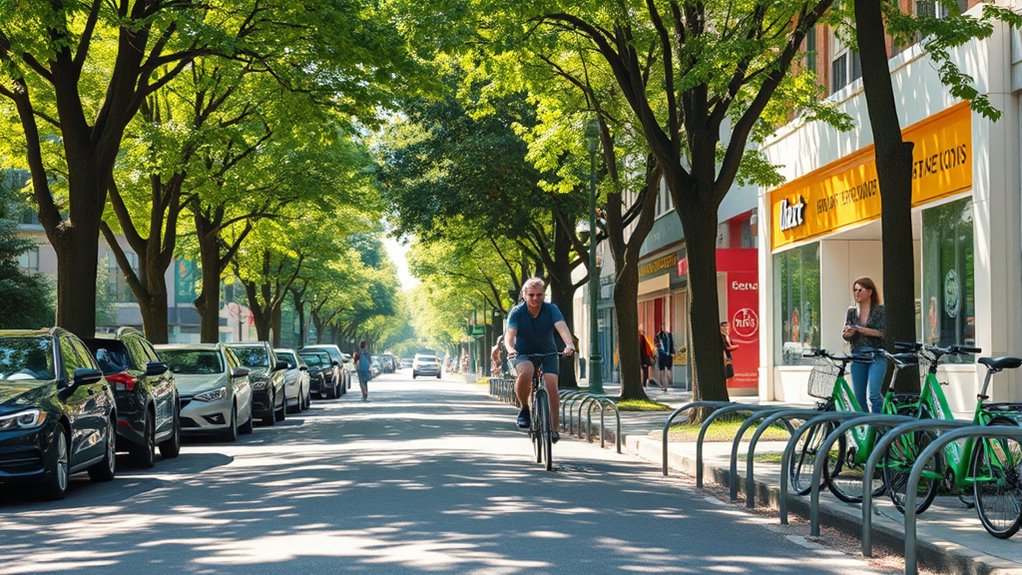
Without a car, you considerably reduce your energy consumption and conserve valuable resources. Your daily transportation shifts mean less fuel use and lower emissions. Additionally, you contribute to water conservation and support renewable energy efforts. Here are four ways you save resources:
- Reduced fuel consumption, decreasing reliance on non-renewable energy sources.
- Less electricity used for vehicle maintenance and charging, supporting renewable energy integration.
- Lower water use for vehicle washing and maintenance.
- Decreased need for manufacturing new cars, saving raw materials and energy.
Promoting Sustainable Urban Development

By choosing to bike instead of drive, you help reduce urban pollution and improve air quality. This shift also encourages stronger community connections as people interact more on local streets. Together, these changes support the development of more sustainable and livable cities.
Reduced Urban Pollution
Have you ever considered how reducing car usage can considerably lower urban pollution levels? Less traffic means cleaner air and quieter streets. Here’s what you’ll notice:
- Decreased urban noise—fewer engines and horns create a calmer environment.
- Lower emissions—reducing vehicle exhaust cuts air pollution and greenhouse gases.
- Eased traffic congestion—less congestion speeds up travel and reduces idling emissions.
- Improved public health—better air quality decreases respiratory issues and promotes well-being.
Enhanced Community Connectivity
Reducing car dependence fosters stronger connections within communities by encouraging more face-to-face interactions and shared spaces. Without the distraction of cars, you’re more likely to engage with neighbors and participate in local events, boosting community bonding. Walking and biking make spontaneous conversations easier, creating a sense of trust and familiarity. This heightened interaction supports local business growth, as you’re more inclined to visit neighborhood shops, cafes, and markets. When you rely less on vehicles, the community becomes more walkable, vibrant, and interconnected. These connections foster a sense of belonging and shared responsibility for urban development. Ultimately, your choice to bike instead of drive not only benefits the environment but also creates a more cohesive, resilient community.
Encouraging Eco-Friendly Lifestyle Choices

Adopting eco-friendly lifestyle choices starts with small, intentional actions that add up over time. You can begin by embracing urban cycling, which reduces emissions and keeps you active. Consider planning eco-tourism trips that prioritize local, sustainable destinations, minimizing your carbon footprint. Here are some ways to encourage eco-friendly habits:
- Use your bike for daily errands and commutes instead of driving.
- Choose eco-tourism adventures that support conservation efforts.
- Reduce plastic use by carrying reusable bags and bottles.
- Support local businesses that prioritize sustainability.
These simple steps promote a greener lifestyle and inspire others to follow suit. Small changes in your routines can lead to significant environmental benefits, reinforcing your commitment to a healthier planet.
Challenges and Limitations of a Bike-Only Year
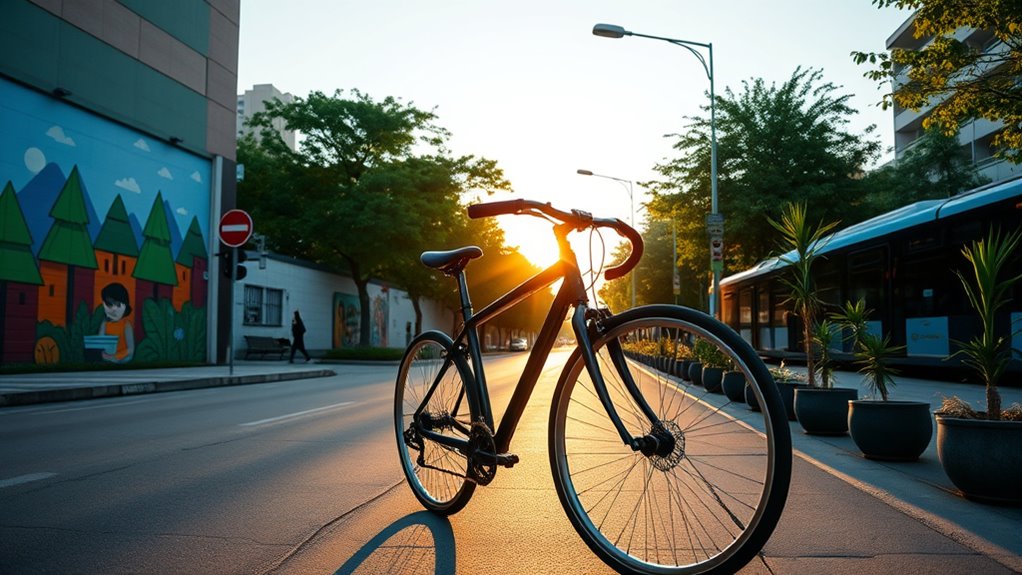
While cycling offers many environmental benefits, committing to a bike-only year presents several practical challenges. Parking becomes a significant issue, as finding secure, convenient spots for your bike can be difficult, especially in busy areas. You might need to invest in quality locks and secure storage solutions to prevent theft or damage. Additionally, bike maintenance is an ongoing responsibility; flats, worn parts, and weather-related wear and tear require regular attention. Without access to a garage or repair shop, you may find yourself struggling to keep your bike in good condition. Weather conditions can also limit your riding days, forcing you to plan around rain, snow, or extreme heat. These limitations highlight that a bike-only lifestyle demands careful planning and adaptability.
Long-Term Environmental Benefits of Biking Adoption
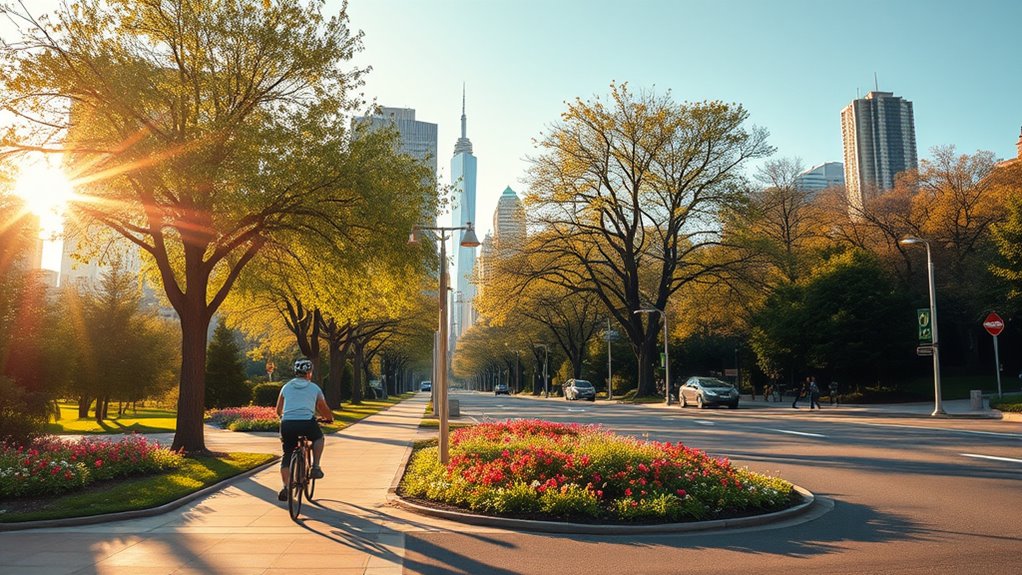
Committing to a year without a car and relying solely on a bike can lead to significant long-term environmental gains. Your adoption of biking influences urban planning by encouraging cities to develop better bike infrastructure, reducing dependency on fossil fuels. Over time, this shift can:
- Decrease air pollution, improving air quality and public health.
- Lower greenhouse gas emissions, combating climate change.
- Promote more sustainable urban development with expanded bike lanes.
- Reduce noise pollution in city environments.
These changes foster eco-friendly cities, making biking a crucial part of long-term environmental health. As your habits influence local policies, you help create a more resilient, green urban landscape. Your commitment contributes to a sustainable future, emphasizing the importance of bike infrastructure and thoughtful urban planning.
Frequently Asked Questions
How Does Biking Affect Mental Health and Overall Well-Being?
Biking boosts your mental health and overall well-being by promoting mindfulness practices that keep you present and reduce stress. It also enhances social connectivity as you meet others during rides or group events. Regular biking releases endorphins, which lift your mood and increase energy levels. Plus, being outdoors helps you reconnect with nature, fostering a sense of calm and clarity that benefits your mental state and overall happiness.
What Are the Economic Savings From Not Owning a Car for a Year?
By not owning a car for a year, you save considerably on fuel and maintenance costs. You avoid paying for gas, oil changes, repairs, and insurance, which adds up over time. Plus, you won’t have expenses for parking or depreciation. These savings can amount to hundreds or even thousands of dollars annually, making biking a financially smart choice while also supporting your eco-friendly lifestyle.
How Does Bike Infrastructure Impact Community Safety and Accessibility?
Imagine safer streets where you don’t worry about traffic congestion or poor air quality. Bike infrastructure directly improves community safety by creating dedicated lanes, reducing accidents, and encouraging more people to cycle instead of drive. This accessibility benefits everyone, especially vulnerable pedestrians and cyclists. As more bike-friendly spaces emerge, you’ll notice cleaner air and less traffic, making your daily commute safer, healthier, and more enjoyable.
Can Cycling Replace Public Transportation in Urban Areas?
Cycling can replace public transportation in urban areas with sufficient bike lane expansion, making riding safer and more accessible. However, you’ll face challenges like increased traffic congestion during peak hours, which could limit bike efficiency. While bikes reduce emissions and promote health, they may not fully serve long-distance or multi-stop trips, so combining cycling with existing transit options often provides the best balance for urban mobility.
What Are the Social Impacts of Adopting a Bike-Only Lifestyle?
Imagine your neighborhood as a vibrant hive, buzzing with social connectivity. Adopting a bike-only lifestyle boosts community engagement, making you more approachable and connected. You’ll meet neighbors at local events and feel more involved. Studies show bike-friendly areas foster stronger social bonds. By choosing two wheels over four, you create a sense of belonging and trust, transforming your urban space into a lively, interconnected community.
Conclusion
Imagine the positive change you could make by ditching your car for a year and embracing your bike. You’d slash your carbon footprint, improve air quality, and promote healthier cities. Isn’t it time we all considered how small daily choices can lead to big environmental impacts? By choosing pedal power, you’re not just transforming your life but helping create a sustainable future for everyone. Are you ready to take that first ride toward change?
